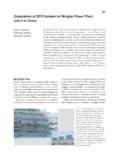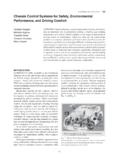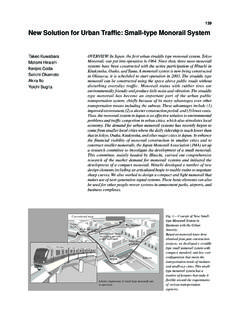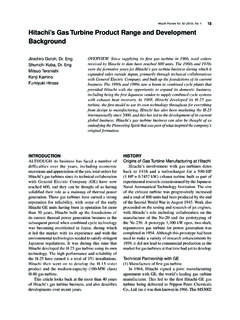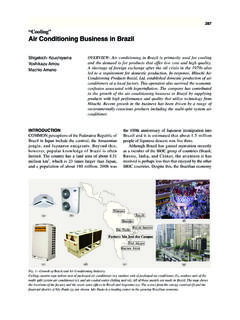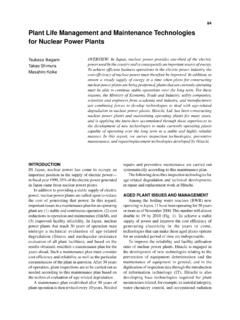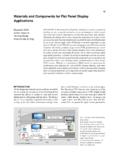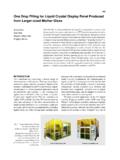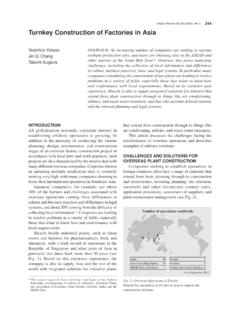Transcription of Vehicle Control Techniques for Safety, Environmental ...
1 ARTICLESA utonomous Driving Technology for Connected Cars1. IntroductionThere is consistent demand from the public for the eradication of traffic accidents. Electronic stability Control (ESC) and automatic emergency braking (AEB) have become standard features for accident prevention, with vehicles also coming on the mar-ket that are equipped with the ability to keep within their lanes on a highway with minimal steering input from the driver. Along with these advanced driver assistance systems (ADAS) and autonomous driv-ing systems, competition is also intensifying on the development of systems for electric drive, including electric vehicles (EVs) and hybrid electric vehicles (HEVs).Drawing on know-how built-up over many years of involvement with conventional products, Hitachi Automotive Systems has been working on adopting electronic and electrical operation for brakes, steering, and suspension, parts that influence Vehicle driving, cornering, and stopping performance.
2 The company has also been developing intelligent technologies and Environmental sensing Techniques that enable safer autonomous driving. Through integrated Control that harmonizes the operation of these different technolo-gies, Hitachi intends to contribute to the achievement of zero accidents and zero Environmental impact by delivering a high level of comfort, Environmental per-formance, and article describes progress on the development of integrated Vehicle Control and chassis components as well as the prospects for the future (see Figure 1).Kentarou UenoTomoaki FujibayashiMitsuo SasakiMasaru KonishiTooru TakahashiHitachi Automotive Systems, Ltd. supplies a wide variety of chassis products that influ-ence driving, cornering, and stopping performance, including both conventional and electrically powered components. The company is also developing integrated Vehicle Control systems in which these components in turn work with a wide variety of Control Techniques to improve Vehicle safety and comfort.
3 In the future, Hitachi intends to contribute to the public role of vehicles through enhancements both to core compo-nents (brakes, steering, and suspension) and to integrated Control for achieving high levels of safety, Environmental performance, and comfort in anticipation of the era of autonomous Control Techniques for Safety, Environmental Performance, and Ride ComfortHitachi Review Vol. 67, No. 1 064 Integrated Vehicle Control2. 1 Integrated Vehicle Control for Autonomous DrivingThe requirement for past automotive systems has been to deliver driving, cornering, and stopping perfor-mance that faithfully responds to the actions of the driver while also maintaining comfort, with enhance-ments having led to improvements in the various sub-systems that include the engine, brakes, steering, and suspension. However, to allow for a future in which use of electrically powered components and electric vehicles is the norm, and that includes autonomous driving in which electronic Control has progressed to the point of replacing the driver, it will be essential to consider how to develop all aspects of Vehicle perfor-mance in an integrated , Hitachi is developing the Control -lers for integrated Vehicle Control that are needed to optimally Control and integrate large numbers of components and supply safe Vehicle systems that also maintain comfort.
4 These controllers handle the con-trol of numerous components by integrating Control signals from the various sensors and other controllers involved in Control functions that deal with sensing and decision-making. The result is the seamless pro-vision of a comfortable ride in a variety of different situations, extending from automatic parking, where the requirement is for turning sharp corners at low speed, thorough to lane-keeping and other high-speed driving functions. The controllers for integrated Vehicle Control also serve to enhance reliability by taking advantage of component-level redundancy to switch over to backup components in the event of failure. They also include backup functions invoked when a supervisory controller fails. This means that, even if commands from a supervisory controller are interrupted, the controller keeps the Vehicle on the intended trajectory and safely hands over Control to the human driver during autonomous driving, or selects a safe place to pull over and bring the Vehicle to a halt (see Figure 2).
5 The presence of controllers for integrated Vehicle Control means that the super-visory controller can implement coordinated Control of Vehicle systems simply by specifying the desired direction, speed, and trajectory, and that a comfort-able ride can be provided based on the road surface and Vehicle conditions with high reliability and in accordance with the 2 Integrated Control of Electric VehiclesAutomotive manufacturers are working to develop vehicles that place a low load on the environment against a background of global warming and atmo-spheric pollution. Electric vehicles (EVs and HEVs) Driving automation level 2 2015 Driving automation levelIntegrated Control of Vehicle motionSteeringBrakesSuspension2020202520 30(year)Retention of functionBEPS/DEPSE lectrically operated brakesSemi-active suspensionQuick-responsesemi-active suspensionActive suspensionwith limited operationActive suspensionRedundancyRear-EFC4W-EFCR edundancyHigh outputSteer-by-wireDriving automationlevel 3 Integrated Control AD L3 Integrated controlAD L4 system safetyMaintain or switch functions when system disabledIntegrated controlAD L2 Comfortable rideZero-G ride comfortDriving automationlevel 4 Figure 1 Roadmap for Integrated Vehicle ControlAlong with enhancing individual components to keep pace with advances in autonomous driving, Hitachi is also developing Techniques for the integrated Control of these components to provide highly reliable automotive systems that provide safety and : advanced driver assistance system AD: autonomous driving EPS: electric power steering BEPS.
6 Belt EPS DEPS: dual-pinion EPS EFC: electric-fist-type an effective way of achieving these envi-ronmental goals. This shift toward electric vehicles is advancing rapidly, with Europe having recently announced that sales of internal-combustion-engined vehicles will be banned by products of Hitachi Automotive Systems include key components for HEVs and EVs, namely motors, inverters, batteries, and controlled vacuum-less brakes. To obtain knowledge of the coordinated Control of these components in combination and how to use them on the road, Hitachi has built test vehicles with front-engine/front-drive (FF), front-engine/rear-drive (FR), and 4-wheel-drive (4WD) configurations, and has developed EV drive Control and coordinated Control Techniques to acquire knowl-edge about the coordinated Control of electric vehicles and its on-road has demonstrated that superior Vehicle performance is achieved by incorporating different types of coordinated Control and integrated Control in a 4WD prototype Vehicle with front and back motors that has the Control configuration shown in Figure 3.
7 In the future, Hitachi intends not only to supply key components, but also to use these as a means for providing development solutions by enhancing know-how acquired in car making and improving performance evaluation, system design, and develop-ment efficiency Brake SystemsProgress is being made on the adoption of electrical brake systems with the aim of improving safety, envi-ronmental performance, and ride comfort. Hitachi has already successfully commercialized ESC, electric boosters, and electric parking brakes. To meet the demands of electric power trains and autonomous driving, two areas where rapid expansion is expected, brake systems will need higher levels of reliability, responsiveness, and Control performance than ever before. Meanwhile, it is anticipated that brake-by-wire (BBW ) systems that operate under the Control of both the Vehicle and the driver will be needed to provide customers looking for greater driving enjoy-ment with better brake feel, and such systems are cur-rently under development.
8 Although existing BBW systems include electro-hydraulic systems that work by the fluid pressure generated by electric motors and pumps, it is anticipated that electric-fist-type cali-per (EFC) electromechanical brakes that use electric motors to Control braking force directly will be needed SurroundEye, autonomous parkingAD, Autonomous driving ECUC ameras, radarVehicle informationPull-over trajectorySafe pull-over areaSemi-activesuspensionIntegrated Vehicle Control ECUEFCE lectric motorHigh-frequency Vehicle vibrations(juddering or shimmying)PitchingPitchingGyGxRolling + yawingGx(Deceleration)Gx(Acceleration)Gy (Cornering)External factors(road surface, cross-winds, etc.)EPS1234567 Figure 2 Integrated Vehicle ControlThe integrated Vehicle Control ECU controls the movement of the Vehicle based on a target trajectory supplied by a supervisory controller (left).
9 It pro-vides safe and comfortable Vehicle behavior by managing the operation of each component in an appropriate way (top right). Failure of the supervisory controller does not interrupt autonomous driving and instead the ECU follows the safest trajectory (bottom right).ECU: electronic Control unitHitachi Review Vol. 67, No. 1 066 067 FEATURED achieve responsiveness and Control performance. As the precise Control that is possible when using elec-tromechanical brakes on the two rear wheels brings numerous advantages, including safety, comfort, and performance, Hitachi is developing hybrid systems with highly reliable electro-hydraulic BBW on the front wheels and precise and responsive electrome-chanical BBW on the rear (see Figure 4). This con-figuration is based on use of Hitachi s brake master cylinder (MCYL) and ESC technology on the front wheels and electric parking brake technology on the rear, and is a quick way to achieve the level of quality needed to make the system available to customers.
10 In comparison to existing hydraulic systems, the ability of this system to harvest regenerative energy over a broad range, as well as its not requiring energy in any form other than electric power, makes it ideal for EVs and HEVs. In addition to shortening the stopping distance for emergency braking, the system is also considered to be suitable for autonomous driv-ing because it allows for advanced Vehicle dynamics Control and because of the redundancy provided by having two different types of braking. The system can also take advantage of the ability of BBW to provide flexibility in brake feel to provide drivers with the feel they prefer, and to maintain a smooth brake feel without any disconcerting behavior in the transition from autonomous driving to driver Control . It provides a high level of ride comfort combined with safety and consideration for the power limitWheel speedAcceleratorShi /paddleBrake pedalYaw rateLateral accelerationPressure commandSteering angleLongitudinal accelerationTorque limit valueTorque limitation and distributionMotor ABS/TCST orque commandRearCANS ensorFrontBrake LSDD amping controlMotor current controlBrake pressure controlABSESCHSAE xternal torque command receivingDriver s torque commandDriver s braking force commandCooperative regenerative brakingMotor speedVehicle Control moduleMotor controllerBrake controllerFigure 3 Block Diagram of Integrated Vehicle Control on Prototype 4WD Vehicle with Front and Rear Electric MotorsThe Vehicle Control module performs integrated Control of the motor controller (electric power con-trol) and brake controller (behavior Control ).
